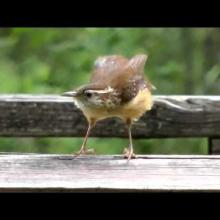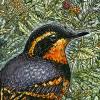

Join BirdNote tomorrow, November 30th!
Illustrator David Sibley and actor H. Jon Benjamin will face off in the bird illustration battle of the century during BirdNote's Year-end Celebration and Auction!
Hurricanes bring tragedy not only to people, but also to birds and other wildlife. Severe storm winds may kill many birds and blow others far from their normal range. Although many individuals die, most populations of birds are resilient, able to spring back from disaster if conditions allow. Many small birds, like this Carolina Wren, breed twice in a season. Fortunately, the effects of natural disasters are usually local, and bird populations on a grand scale can, literally, weather the storm.
BirdNote®
Hurricanes and Birds
Written by Dennis Paulson
This is BirdNote!
[Newscaster reporting on a hurricane, hurricane winds and waves.]
Hurricanes threaten human life and property. They also bring tragedy to birds and other wildlife. Severe storm winds not only kill many birds but blow others, especially seabirds, far from their normal range.
[Sooty Tern calls]
During and after a hurricane, Sooty Terns, like the ones we’re hearing, and other seabirds from the Caribbean turn up widely in our country’s interior, blown hundreds of miles from the sea. Caribbean land birds, however, fare better, hunkering down and generally avoiding being blown away.
But it’s important also to know what happens after these disasters. Although many individuals die, most populations of birds are resilient, able to spring back from disaster if conditions allow. [Carolina Wren song].
Many small birds like the Carolina Wren we’re hearing breed twice in a season, and some of them lay five eggs or more in a clutch. If such attempts were completely successful, a pair could produce ten or more young each breeding season. It wouldn’t take long to have the population up and flying again!
[Carolina Wren song]
Fortunately, the effects of natural disasters are usually local, and bird populations on a grand scale can, literally, weather the storm.
[Carolina Wren song—long clip]
For BirdNote, I’m Michael Stein.
###
Bird sounds provided by The Macaulay Library of Natural Sounds at the Cornell Lab of Ornithology, Ithaca, New York. Sooty Terns recorded by W.V. Ward. Carolina Wren song recorded by T.A. Parker III.
Producer: John Kessler
Executive Producer: Chris Peterson
© 2013 Tune In to Nature.org August 2017 / 2021 Narrator: Michael Stein
ID# 082206cane1KPLU hurricane-01









